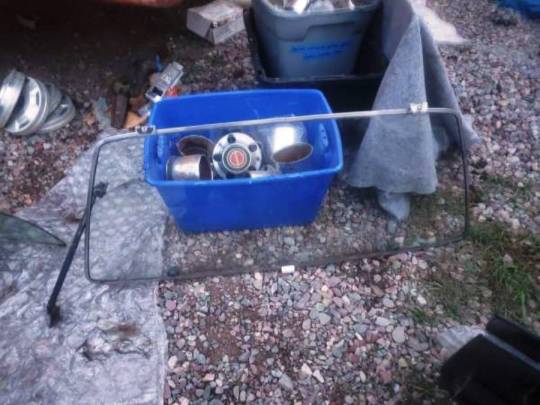#1972 gremlin
Explore tagged Tumblr posts
Text

From the car files: a 1972 American Motors model line ad.
#vintage advertising#american motors#amc#70s cars#1972 gremlin#vintage cars#classic cars#the 70s#the 1970s#1972 hornet#1972 javelin#american cars#1972 cars
11 notes
·
View notes
Text




American Motors Gremlin X, 1972. The X package was a $300 option that included body side stripes, slotted road wheels with D70x14 Goodyear Polyglas tires, blackout grille insert, bucket seats and "X" decals. The roll-back canvas sun-roof was a further option
#AMC#American Motors#AMC Gremlin#American Motors Gremlin X#AMC Gremlin X#1972#sub compact#dead brands#Gremlin X
510 notes
·
View notes
Text



Valve cover shenanigans. When your new valve cover to stop oil leaks doesn't fit your older style PCV valve.
0 notes
Text
John Lennon and Yoko Ono: his affairs, binges and diet pills
For years the radio host Elliot Mintz was the only person the former Beatle and his wife trusted. Now, he has written a book about his intense relationship with the couple — including what really happened during Lennon’s infamous ‘Lost Weekend’
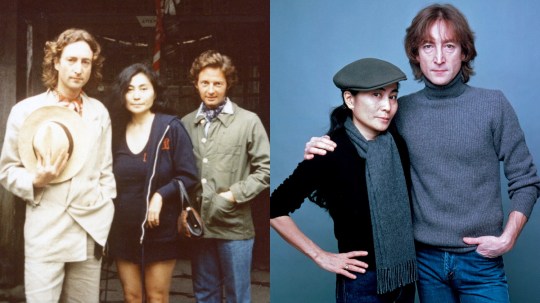
John Lennon, Yoko Ono and Elliot Mintz outside the Mampei Hotel in Karuizawa, Japan, 1977. Right: Lennon and Ono in 1980
I am holding a pair of glasses. They are antique, made of steel wire and perfectly round. The trademarked name is the Panto 45. This is the 26th pair of John’s glasses I’ve examined on this snowy night in February 1981. It’s been about two months since he was gunned down in New York outside the Dakota, the gothic edifice where he and Yoko Ono had been living since 1973.
I’ve been tasked with the responsibility of inventorying his personal effects so that Yoko, and posterity, would know precisely what he had left behind. I did not want this task. For one thing, I live 2,500 miles from the Dakota, in Los Angeles, where I host a late-night radio interview show. But Yoko asked me to do it, and I have rarely been able to say no to Yoko, let alone John.
I found their idealism infectious and inspiring. Still, as I got to know John and Yoko as flesh-and-blood friends, I began to see their flawed human sides as well.
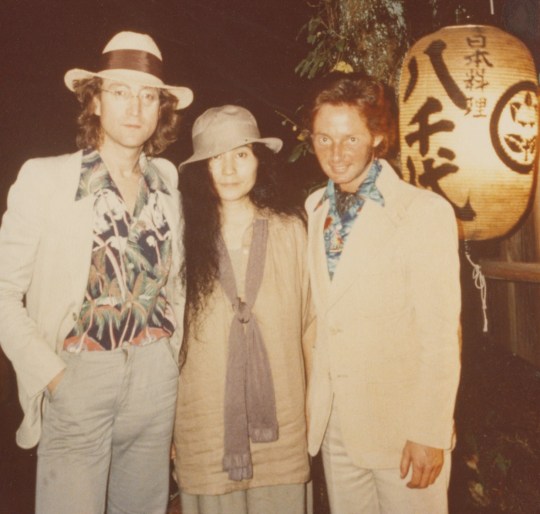
The trio at a restaurant in Kyoto, 1977
Yoko, for one, was even more airy and ethereal in private than she was in the media. She could be a fountain of aphorisms, dispensing endless nuggets of Zen-like philosophy. Her haiku-esque homilies on manifesting one’s desires or the wisdom of the nonrational mind could be a bit much for some people.
There were moments when even I was a bit baffled by it all. Except then she would say or do something that would absolutely convince me that she was connected to some higher plane.
John, meanwhile, was every bit as charming, funny and intelligent as he came across in public. But I gradually discovered he was far from perfect. For starters, for a guy who aspired to be a world-shaking peacemaker — a thought leader on a par with Mahatma Gandhi, Martin Luther King Jr and Nelson Mandela — he was surprisingly uninformed about historic figures like, well, Gandhi, King and Mandela.
He also had some Luddite-like notions about science, particularly medicine, extending well beyond his annoyance at “daddy doctors” for not letting him perform his own weight-loss injections. Even though John had smoked, ingested or snorted just about every illegal recreational drug he could get his hands on, he was weirdly suspicious of the ones that were properly prescribed and proven efficacious.

Lennon and Ono on The Dick Cavett Show, 1971
John and Yoko could be incredibly sensitive, honest, provocative, caring, creative, generous and wise. They could also be self-centred, desperate, vain, petty and annoying. In John’s case, also shockingly cruel — even to Yoko.
An example…
Early one morning in November 1972, the red ceiling light that would flash whenever my hotline to John and Yoko rang started blinking. I picked up.
“Ellie, I f***ed up,” were the first words out of John’s mouth.
“Why?” I groggily asked. “What did you do?”
“We were at this party last night,” he said, “and I got loaded. And there was a girl…”
I sat up in bed.
The party was at Jerry Rubin’s Greenwich Village apartment. A small crowd of well-connected peaceniks had gathered to watch the presidential election returns on television. As it became clear that Richard Nixon would win re-election by a landslide, the mood grew bleaker and the crowd began drinking more heavily.
Alcohol was not John’s friend and on this occasion, John’s evil inner gremlins truly outdid themselves.
I got some of the specifics from a hungover John during his morning-after call. The upshot was that John had indeed hit it off with some girl at the party and had slipped into a bedroom with her, where they proceeded to have such loud, raucous sex that everyone sitting around the TV in Rubin’s living room — including Yoko — could clearly hear them going at it.

Lennon and Mintz in 1972
At one point, a well-meaning guest put a record on the turntable — Bob Dylan’s 11-minute ballad Sad Eyed Lady of the Lowlands — at high volume. Yoko sat on the sofa in stunned, mortified silence.
Whatever they said to each other later, I suspect the conversation was not a pleasant one.
“I slept on the sofa,” John told me, sounding defeated and embarrassed — although, frankly, not quite as contrite as I thought his situation warranted. “Things like that happen,” he said, way too matter-of-factly for my taste. “A bloke cheats on his wife… If I weren’t famous, nobody would care.”
Yoko, unsurprisingly, felt differently.
“Are you OK?” I gently asked her when I phoned to check in on her a few hours later.
“There is no answer to that question,” she said shakily.
“Do you think you’ll ever be able to forgive him?”
“I can forgive him,” she said. “But I don’t know if I can ever forget what happened. I don’t know if it will ever be the same.”
After a few weeks of cooling down, though — during which Yoko wrote and recorded Death of Samantha, her bluesy ode to burying one’s pain for the sake of outward appearances — the crisis seemed to abate. John and Yoko chose to roll the cosmic dice with a spectacular gesture of faith and hope in the staying power of their love. They bought an apartment in the Dakota.
“It’s apartment No 72,” Yoko announced when she called to tell me about the purchase. “Do you see the significance?”
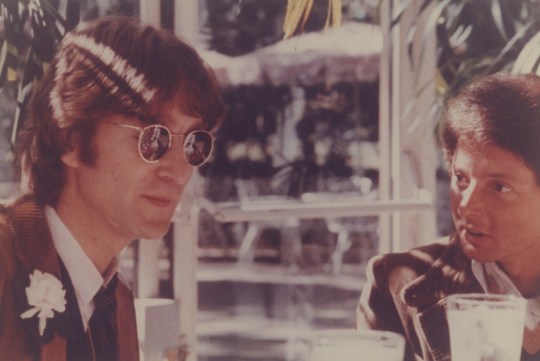
Lennon’s 38th birthday party, 1978
When you add seven and two, you get nine, Yoko explained, which was a hugely significant numeral to the Lennons, a magic integer that seemed to mysteriously recur throughout John’s life. Yoko would rattle off the number’s many repeated appearances: John was born on October 9. She was born on February 18 (1 plus 8). Paul McCartney’s last name has nine letters…
I was somewhat mystified as to why they chose this particular neighbourhood. “Aren’t you worried it’ll be too stuffy for you?” I asked John. “Will the people who live there even know who you are?”
“I don’t want them to know who we are,” he said with a laugh. “I don’t want to know who they are. We just want to be left alone.”
The Dakota struck me as one of the most eerily beautiful — and oddly daunting — structures in all of New York. John and Yoko greeted me in the vaulted vestibule, eager to begin our tour, which started on the ground floor with the new headquarters for Studio One, the business entity behind John and Yoko’s creative enterprises. Tellingly, John did not have an office in Studio One; Yoko did.
The main attraction was on the seventh floor. It was nearly 5,000sq ft, with massive windows offering eye-popping views of Central Park. Virtually everything in its expansive living room, from the plush carpeting to the grand Steinway piano, was as white as Japanese snowbells.
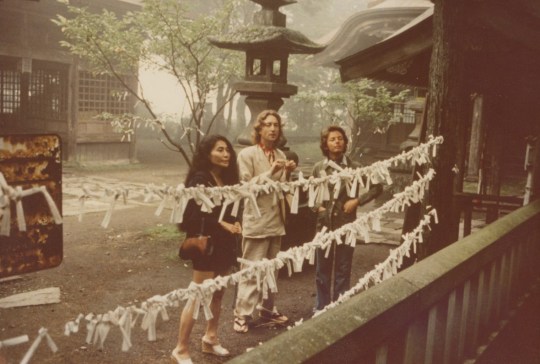
Lennon, Ono and Mintz at a Shinto temple in Kyoto. The custom was to hang your horoscope on a line
There was only one highly conspicuous work of art in the White Room: a Plexiglass case on a white pedestal, in which was a 3,000-year-old sarcophagus. John and Yoko had scored the very last mummy allowed out of Egypt before the Egyptian government put a ban on exporting their national antiquities.
“You should x-ray it and see what’s inside,” I suggested. “There might be something of great value, like precious jewels.”
“I don’t care what’s inside,” Yoko responded. “The great value is the magic of the mummy itself.”
Another thing I clearly remember about that long afternoon at the Dakota was how enthusiastic both John and Yoko seemed about the life they were building together in this new nest. John giddily described the “entertainment centre” he wanted to construct in a nook off the kitchen. Yoko, ever the artist, chattered about the endless design ideas she had. It was all too easy to forget about the pain and stress they’d been dealing with. I managed to convince myself that the worst was over for John and Yoko. I was wrong.
There are those who believe Yoko not only approved of the affair but arranged it. That she planted May Pang in the seat next to John on that American Airlines flight from New York to Los Angeles knowing full well what was likely to happen. That their comely 23-year-old assistant would sooner or later end up sleeping with her husband.
It’s possible, I suppose. It could be she saw some strategic long-term advantage in setting up the affair; by handpicking John’s mistress, she might have felt she could exert some dominion over his extramarital wanderings. Perhaps, thanks to her mystical advisers, she really did see that John was heading for a free fall and was endeavouring to soften his inevitable crash.
If any of that is true, though, Yoko never breathed a word of it to me. All she said in October 1973 was that she was sending John and an assistant to LA. Could I please meet them at the airport?
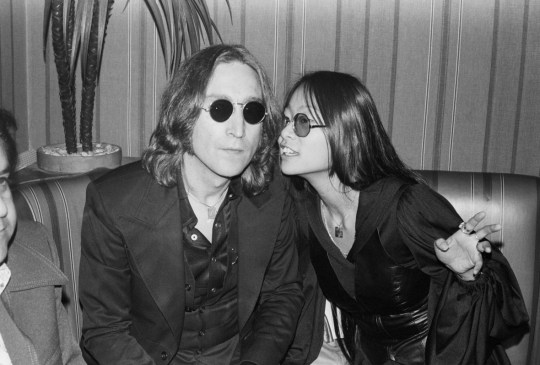
With his assistant and lover, May Pang, 1974
I was by then aware that their marriage was in deep trouble. Despite their best efforts to mend the relationship, the red light on my bedroom ceiling had been blinking even more feverishly than usual leading up to what would later be known as John’s “Lost Weekend”, the 18 months he spent in exile from his wife in New York.
Yoko’s demeanour back then, as always, was not demonstrably emotional but it was clear from our phone conversations that she was in pain. John’s calls were every bit as depressing.
“Has Mother been talking to you about us?” he asked during one early morning chat.
“Yoko talks to me about everything,” I answered vaguely.
“The other day I shaved and got dressed up and told her I wanted to take her to her favourite restaurant and she turned me down,” he lamented. “She said she didn’t have time. Me own f***ing wife said that to me!”
Yoko has always been a methodical person, and my guess is that she precisely and carefully orchestrated John’s eviction from the Dakota. John might not have even realised what was happening to him. He certainly didn’t seem like a man who’d been kicked out of his home when I met him and May Pang at LA airport.
“You look trim, Ellie,” he said with a big grin when I greeted them. “Have you been taking those diet pills again?”
They had very little luggage, suggesting that neither of them was expecting a long stay. My instructions from Yoko were to drive them to music manager Lou Adler’s house in Bel Air, a mini-mansion up on Stone Canyon Road.
“I need some money,” John said as we settled into my weary old Jaguar. “Mother said these could be used for money,” John continued, shoving a fistful of traveller’s cheques in my hand.
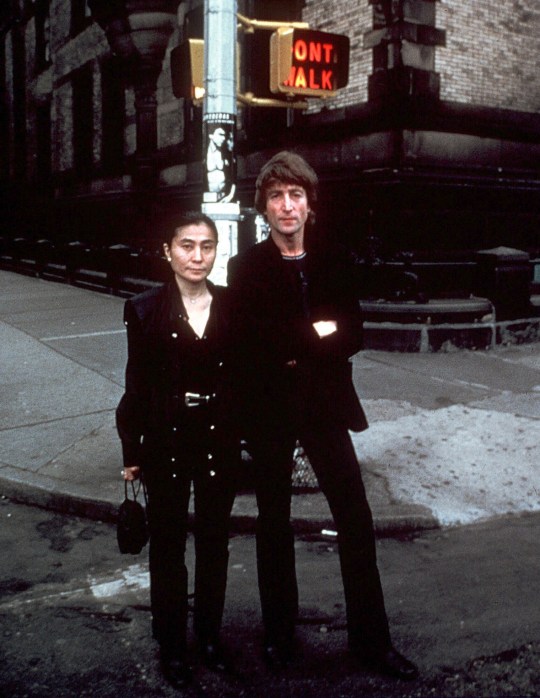
The couple outside the Dakota building in New York, 1980. They bought an apartment there in 1973
John was functionally a child when it came to taking care of himself. But then, that was what May was for. Whatever other intentions Yoko may or may not have had for the assistant, her primary job was to make sure John was properly fed and cared for, that all his basic needs — or at least most of them — were satisfied.
John and I spent a lot of time together over the next several weeks. He was also expanding his friendship circle in LA, hanging out with people like Harry Nilsson, the brilliant but notoriously hell-raising singer-songwriter. But after three or four months, much of his initial enthusiasm had boiled off and his mood was starting to curdle. He was missing Yoko: he began asking me when I thought she’d be ready for him to come home. He started spending more and more time with Nilsson, drinking at the Troubadour till all hours. After John famously got thrown out for drunkenly heckling the Smothers Brothers, the late-night shenanigans moved to the Rainbow Bar & Grill on Sunset. That’s where John and Harry and a collection of others — including my old pals Micky Dolenz and Alice Cooper — formed an infamous drinking club known as the Hollywood Vampires.
It would be difficult to exaggerate the level of unbridled indulgences that took place in the Rainbow’s VIP room, a small alcove atop some stairs overlooking the bar. The amount of alcohol imbibed was staggering, to say the least, and there were also small bags of cocaine discreetly passed into the room. Nilsson, a great big bear of a man, could pound down a dozen or so brandy alexanders — a potent mix of brandy and cream, his cocktail of choice, which John soon adopted as his own — in a single sitting.
Not being a celebrity, I was never invited to become a member of the Hollywood Vampires, but I was a welcome visitor and spent many a late night on the edges of their wild, sometimes harrowing saturnalias.
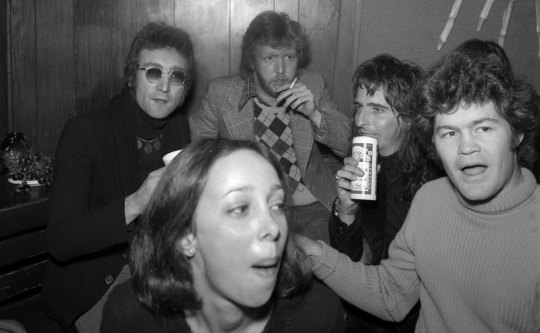
Lennon with his Hollywood Vampires drinking partners, from left, Harry Nilsson, Alice Cooper and Micky Dolenz, November 1973
There was always a crowd of attractive young women at the bottom of the steps leading to the Vampires’ VIP lair. Frankly, though, by the time the boys descended, usually at closing time, most of them were too wasted to take advantage of the opportunity. I lost count of the number of times I all but carried John down those stairs and poured him into whatever car service I had called to the bar’s car park.
For the most part, I kept my promise to Yoko: I kept John safe. But one night, I realised things were starting to spiral out of my control. Normally, John didn’t put up much of a fight when I helped him down the stairs at the Rainbow Bar but on this occasion, he resisted. He didn’t want to go home.
He pushed away and dived straight into the crowd. It was my worst nightmare: a drunken star lost inside a drunken mob.
Finally, I spotted John with Nilsson at the edge of the car park, the two of them climbing into the back of a black limousine. A moment later, it pulled away into the night, going I had no idea where.
John, I realised with a sinking feeling in my gut, was slipping away.
I was about to walk into the nadir of the Lost Weekend, John’s rock bottom. The call came not on the hotline but my regular house phone, and the voice on the other end identified himself as a security officer working for Phil Spector. John was in trouble: could I please hurry over to Adler’s house and help “calm him down”.
What I saw when I stepped into Adler’s living room some 20 minutes later looked like a scene out of The Exorcist. Drunk and wild-eyed, John was strapped to a high-backed chair, his arms and legs restrained with ropes, which he was struggling against with all his might as he shouted obscenities at his captors, a pair of beefy-armed bodyguards who stood in awkward silence nearby. The place was a shambles. John had torn some of Adler’s framed gold records off the walls and smashed them to pieces. Bits of broken wood and shattered Plexiglass littered the floor.
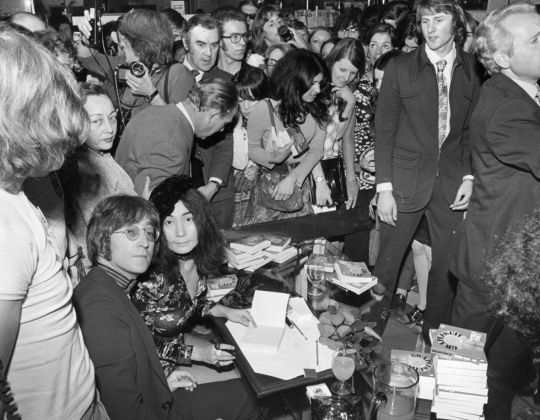
The couple in Selfridges in London where Ono was signing copies of her book Grapefruit, July 1971
Apparently, the meltdown had started earlier that evening at the studio, where John and Phil had nearly come to blows. What precisely they were arguing about, nobody seemed to remember. But the session ended early with Phil’s guards restraining John and shuttling him to Adler’s house, where John slipped away from them long enough to pick up some sort of walking stick or cane, which he swung wildly around the living room until the guards were able to subdue him.
I slowly stepped up to John, who had stopped shouting. His head hung low on his shoulders, his chest heaving furiously. After a long beat, he slowly lifted his eyes to me. He looked possessed.
“Get these ropes off me!” he erupted. “Get them off me, you…”
And then John spat out an epithet so hurtful and offensive, I can’t bring myself to repeat it.
I looked straight into his eyes, barely containing my disgust and disappointment. He looked back into mine. And that exchange of glances seemed to reach some shred of humanity buried deep in John’s alcohol-addled brain. Suddenly he became very, very quiet.
After a moment or two, I turned to the guards. “I think you can take those ropes off him,” I said. “I think he’s done.”
John stood up, rubbed his wrists and, without another word, slowly made his way down the hall to the bedroom, where he must have collapsed on the mattress and passed out.
The next day, as I was getting ready to leave for work, the hotline started flashing.
“Ellie?” John said. “I’m sorry for what I said. But if you think about it, if that’s the worst thing I could say about you, you couldn’t be all that bad, right?”
“Thanks for the compliment,” I said.
“Well, welcome to the real world, Mother Virgin Mary. I’m me. I have a big mouth and express meself the way I feel when I feel it. I don’t hide behind some microphone. I sing into it or speak into it when it suits me. I’m not always the Imagine guy or the Jealous Guy or the Walrus. So I said I’m sorry to you. That’s all I can do.
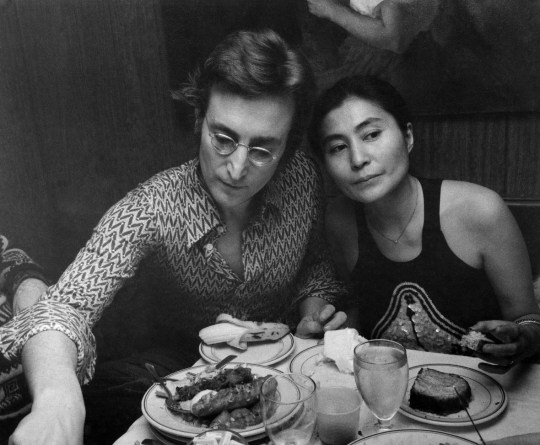
Lennon and Ono in 1972
“Do you want to have dinner?”
“No,” I answered. “I think I’m going to take the night off.”
For the first time I can remember, I was the one who hung up the phone.
Obviously, our friendship took a hit after the incident at Adler’s house; how could it not? For the next several months, John and I barely spent time together — at least, not in person. We would talk almost every day on the phone, as we always had, and eventually our rapport began to feel as easy and familiar as ever. But I no longer joined him for evenings at the Troubadour or the Rainbow.
John, meanwhile, had shifted from the mayhem of the Spector sessions to the slightly lesser bedlam of producing a record for his pal Harry Nilsson. The most notable thing about the Pussy Cats sessions was who else was in the room. Ringo Starr sat in on drums. And although it never made it onto Nilsson’s album, another ex-Beatle unexpectedly turned up and even sang with John, the first time the two of them had performed together since the Beatles split.
I wasn’t present but later heard that Paul McCartney and his wife, Linda, had popped in without warning, bringing Stevie Wonder with them. According to those who were there, John and Paul seemed to pick up their friendship as if they were teenagers again, but when John told me about it later, he was kind of dismissive about it, saying, “They were all just looking at us, thinking that something big was going to happen. To me, it was just playing with Paul.”

Lennon with Harry Nilsson, left, outside the Troubadour club in West Hollywood, having just been ejected for heckling a performance by the Smothers Brothers, March 12, 1974
What John didn’t know, though, was that, according to Yoko, Paul had an ulterior motive for the visit. A few days earlier, she had called me to explain the machinations behind the visit.
Yoko told me she spoke with Paul, who offered to speak with John. “I thought it was very kind,” she said. “I was very appreciative. But I made it very clear to Paul that it wasn’t something I was asking him to do. It would have to be Paul’s idea, not mine.”
To me, there was never any question that John desperately wanted to get back with Yoko. Yes, he had feelings for May, yet at some point during virtually every phone call I had with him, John would sooner or later beseech me to talk to Yoko on his behalf. “Tell Mother I’m ready to come home, Ellie. Tell her I’m a changed man.”
“I don’t think she wants to hear it from me,” I would say. “She wants you to show it to her.”
Paul, I later heard, gave John similar advice. Sometime after popping into the studio in Burbank, he sat down with John and laid out, step by step, what he would need to do to win Yoko back.
It’s impossible to say if Paul’s presentation was what did it, or if John experienced some other epiphany around that time, but over the ensuing months he did indeed begin to clean up his act. In the summer of 1974, he started working on his next album, Walls and Bridges, regularly flying to New York for rehearsals and recordings at the Record Plant on West 44th Street. By all accounts, those sessions were entirely professional, with John showing up 100 per cent sober every day.
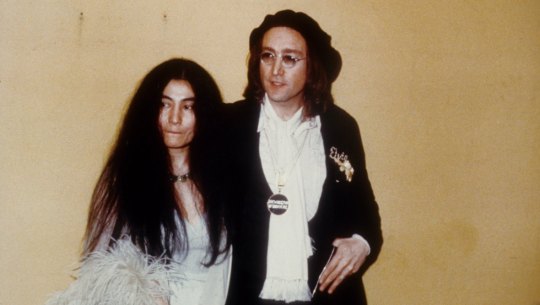
At the Grammy Awards in New York, March 1, 1975
Then, as work on the album neared completion, John made a fateful decision: he decided not to wait any longer for Yoko’s invitation to return to New York. Instead, towards the end of the summer, he and May rented an apartment of their own on the Upper East Side. It was a small but comfortable place that had a wraparound balcony with spectacular views of the East River.
When I flew to New York to tape some interviews, I took the opportunity to pay them a visit — my first face-to-face meeting with John since the ugliness at Adler’s house. It was an awkward encounter for numerous reasons. For one thing, I had just spent an afternoon with Yoko at the Dakota, some 20 blocks away; taking a cab across town to John and May’s felt something akin to betrayal.
Perhaps sensing my apprehension, May gave me a wide berth, leaving to make some phone calls in a bedroom while John and I stood together on the balcony, catching up.
“Does this make you feel uneasy?” John asked after a beat.
“You mean being here with you and May? Yes, a little,” I admitted. “It just reminds me of the fact that you and Mother are still separated, and that makes me sad.”
“Well, that’s the way Mother wants it,” he said. “At least for now.”
Then, unexpectedly, he wrapped his arm over my shoulders and added, “Don’t look so glum, me boy. Put on your radio face. There’s nowhere you can be that isn’t where you’re meant to be.”
It was one of the few times he’d quoted a line to me from a Beatles song.
Walls and Bridges was released a month or so later. John sent a prereleased signed copy (“To my little dream lover on ice, with love and old pianos,” he wrote, referring to my affection for Bobby Darin’s hit song).
As it happened, Elton John had joined John on keyboards for one song on the album. Elton made a bet with John. If the song was a hit, John would have to perform at Elton’s upcoming concert at Madison Square Garden. John agreed, never imagining he’d have to honour that promise.
Of course, Elton was spot on: Whatever Gets You Thru the Night did indeed become John’s first No 1 solo single. And so it came to pass that, in November 1974, onstage at Madison Square Garden, in front of thousands and thousands of fans, that the Lost Weekend finally began to fade to a finish.
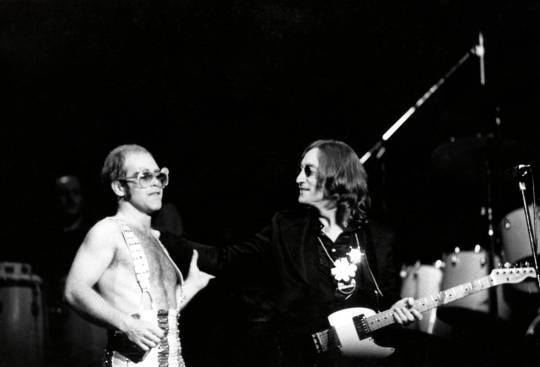
Lennon’s surprise appearance at Elton John’s concert at Madison Square Garden, November 28, 1974
The details of what exactly transpired backstage that night remain, 50 years later, shrouded in some mystery. What is known is that Yoko, who’d been invited to the concert by Elton’s manager, was in the audience. She couldn’t have been prepared for the reaction around her when Elton announced, about two thirds into the concert, that he was bringing John onto the stage for his first public performance in two years. The crowd went berserk.
After the show, Elton’s manager approached Yoko and told her that Elton had requested her presence in his dressing room. Yoko was led backstage to a door with a star on it. She knocked, the entrance opened, and inside she saw her husband standing there, alone.
I cannot tell you what happened after the dressing room door closed behind them. Nobody but Yoko knows that, and she has never shared with me any details. What I can tell you is that in the weeks and months that followed, there must have been many more rendezvous as Yoko and John re-established their connection, even as he continued living with May in their East Side apartment.
According to one of May’s early accounts, John was ultimately hypnotised into ending his relationship with her; she has long claimed that Yoko hired a mesmerist to help John quit smoking but that it was all a ruse to brainwash him into splitting up with her so he could return to Yoko. To this day, many people believe that story. But I know for certain that it wasn’t true. Because, as it happens, I’m the one who arranged the hypnotist.
Yoko had nothing to do with it.
John had remembered that I had interviewed a hypnotist on my radio show and asked me if he might be able to help him kick nicotine.
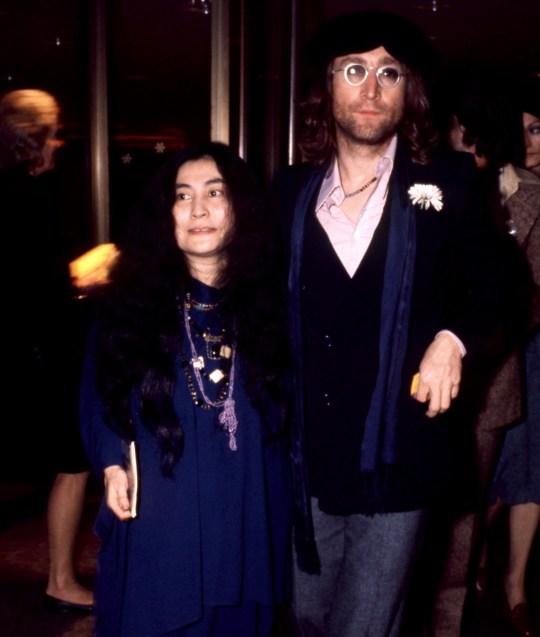
At the Lincoln Center in New York, circa 1975
I called the hypnotist, planned for him to fly to New York, booked him a room in a Midtown hotel, and set up an appointment with John. In just about every respect, though, the hypnosis was a total bust. John told me immediately afterwards he was never put under; the hypnotist claimed John was but just couldn’t remember. The hypnotist also turned out to be something of a diva. He disliked his hotel — he thought the desk clerks were rude — and checked out the next day, flying back to LA in a huff.
John didn’t quit smoking, not for a minute, so it’s hard to imagine the hypnotist had succeeded in brainwashing him into anything else — like, say, leaving a lover. But the very next day, John did break it off with May and returned to the Dakota, resuming his marriage to Yoko and ending, at last, the long and lonely winter that had been the Lost Weekend. He called me in LA shortly afterwards to share the happy news.
He said, “Let the media know the separation did not work.”
‘He’d weigh himself twice a day’
Elliot Mintz on his friendship with John and Yoko. By Georgina Roberts
When a red light in Elliot Mintz’s bedroom flashed, it meant that John Lennon or Yoko Ono was calling him on a special hotline. “In an average week, 20 hours of phone conversation would not be unusual,” the 79-year-old former radio DJ and talk-show host says from his Beverly Hills living room.
Mintz describes the friendship with the couple that “dominated” nine years of his life as “almost a kind of marriage”. He was taken aback when Ono called him in 1971 to thank him for not asking about Lennon when he interviewed her on his radio show. When they began to speak for hours at night, she batted away his concern that her husband might get jealous, saying, “Aren’t you giving yourself a little too much credit, Elliot?”
Lennon first called Mintz to ask if he could get him fat-melting pills. “That was my first conversation with John Lennon. It wasn’t philosophical. It wasn’t about Elvis or the Beatles. It was about weight loss,” he says. Sometimes Lennon would weigh himself twice a day and the couple “were obsessive about diet”.
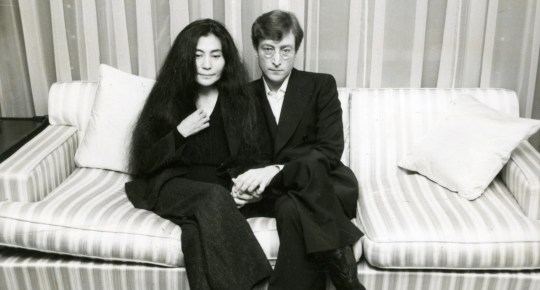
In Hotel Okura in Tokyo, October 1975
After six months of speaking, the couple summoned him to meet them in Ojai, California, where they were trying to kick a methadone addiction. Ono barely spoke until she was in a bathroom with the tap running. “She whispered to me, ‘This house is bugged. Everything we say here, they’re listening. So you have to be very careful what you say.’ ” FBI files released years later showed that Ono wasn’t being paranoid. President Nixon had placed the couple under surveillance after rumours they planned to disrupt his convention, Mintz says.
His clandestine friendship with the couple wreaked havoc on his love life. When he couldn’t explain whom he’d been speaking to in the middle of the night, one love interest assumed he was married and stormed out. “I realised at that moment that my love life would have to take a back seat to my relationship with John and Yoko,” he says.
There were times when lines were crossed in the friendship. One morning, Lennon summoned Mintz to kick out a girl who’d stayed the night. “I told him, ‘Please don’t ask me to do something like that again.’ He flipped out. He said, ‘I will effing ask you to do anything that I feel like asking you to do. Do you understand that?’ ” Mintz was hurt and offended. The next day was one of the few times he said no to “grabbing a bite” with Lennon.
Becoming parents was “the biggest game-changer” for the couple. After his son Sean was delivered via caesarean section in 1975, “John was outraged that when Yoko was clearly struggling, doctors would come up to him and say, ‘I’ve always dreamt of shaking your hand.’ He would bark at them, ‘Look after me wife!’ ”
While Lennon threw himself into childcare, Ono, who came from a banking dynasty, handled the couple’s finances. After becoming stratospherically famous so young, Lennon was “clueless” about money. “I doubt if John was ever in a supermarket, went to a bank, wrote a cheque. That’s what Yoko did,” Mintz says. “If not for Yoko, there’d be no money in the Lennon-Ono estate today.”
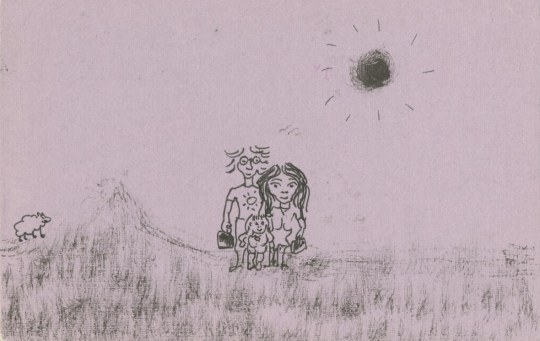
A drawing by Lennon on a postcard from Japan sent to Mintz in 1977
The first time Mintz met their son, Lennon said protectively, “Not too close. Germs.” “He said, ‘Look, we were going to make you the godfather, but we decided on Elton, because he would at least give him better Christmas presents.’ ” “This is typical John,” Mintz says.
Sean would only spend five years with his father before Lennon was murdered outside the Dakota in December 1980. Lennon had always “poo-pooed” Mintz’s requests for him to employ more security. “John said, ‘I’m just a rock’n’roll singer. Who would want to hurt me?’ ”
When Mintz speaks about learning of Lennon’s murder from a weeping flight attendant, his honeyed radio-presenter voice cracks with emotion. “Even now, after all these years, just thinking about that moment…” He trails off. The most gut-wrenching of his responsibilities was making an inventory of Lennon’s possessions. When he signed for a stapled brown paper bag that came from the hospital where Lennon was taken after he was shot, he could not bear to open it. “It was what John was wearing, what he had on him when he fell, including his broken, bloodied glasses.”
He is reticent about his friendship with Ono today. “I want to give her a sense of privacy,” he says, but adds, “It still feels like family. I still love her dearly.” The last time he saw her was at her 91st birthday in February. It was there that Sean encouraged Mintz to write his book, We All Shine On. Does he think Ono will like it? “I’ve never tried to predict a Yoko Ono conclusion.”
How different would his life be if he had never met the couple? “I could have got married. Could have had children.” Were the sacrifices worth it? “Of course. I got to spend that amount of my time with these two extraordinary people.”
We All Shine On: John, Yoko, & Me by Elliot Mintz (Bantam, £25).
(source)
338 notes
·
View notes
Text
All clean now!









Dirty. Stinky and smelly.
4 notes
·
View notes
Text
Stats from Movies 1501-1600
Top 10 Movies - Highest Number of Votes

Ghostbusters (2016) had the most votes with 1,257 votes. Phantoms (1998) had the least votes with 309 votes.
The 10 Most Watched Films by Percentage
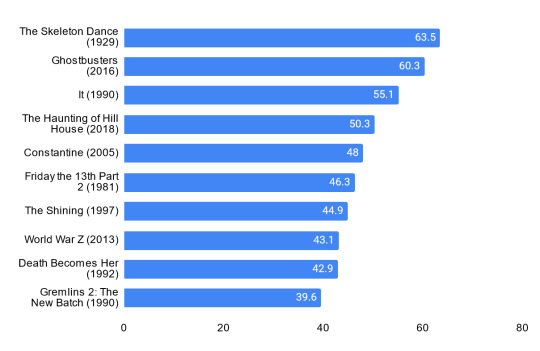
The Skeleton Dance (1929) was the most watched film with 63.5% of voters out of 647 saying they had seen it. It Doesn't Get Any Better Than This (2023) had the least "Yes" votes with 0,7% of voters out of 454.
The 10 Least Watched Films by Percentage

Ghostbusters: Frozen Empire (2024) was the least watched film with 73% of voters out of 449 saying they hadn’t seen it. ¡Corten! (2021) had the least "No" votes with 6,4% of voters out of 390.
The 10 Most Known Films by Percentage
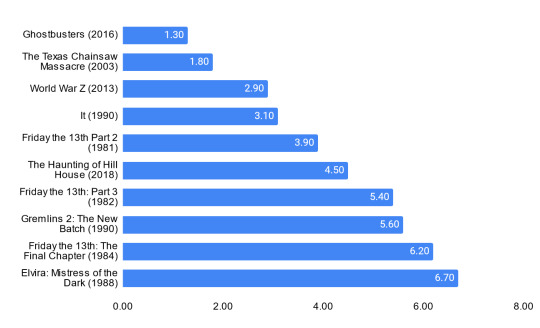
Ghostbusters (2016) was the best known film, 1,3% of voters out of 1,257 saying they’d never heard of it.
The 10 Least Known Films by Percentage

¡Corten! (2021) was the least known film, 92.6% of voters out of 390 saying they’d never heard of it.
The movies part of the statistic count and their polls below the cut.
The Houses October Built 2 (2017) Brightburn (2019) Snow Falls (2023) The Forsaken (2001) Vanishing on 7th Street (2010) The Golem (1920) Friday the 13th Part 2 (1981) Friday the 13th: Part 3 (1982) Friday the 13th: The Final Chapter (1984) Friday the 13th: A New Beginning (1985)
Friday the 13th Part VI: Jason Lives (1986) Friday the 13th Part VII: The New Blood (1988) Jason Goes to Hell: The Final Friday (1993) Manos: The Hands of Fate (1966) Hellbound: Hellraiser II (1988) Hellraiser III: Hell on Earth (1992) The Monster Squad (1987) Dracula 2000 (2000) The Apparition (2012) Ghosts of Mars (2001)
Ice Cream Man (1995) Ghostbusters (2016) Ghostbusters: Afterlife (2021) Ghostbusters: Frozen Empire (2024) Species (1995) World War Z (2013) The Texas Chainsaw Massacre (2003) Village of the Damned (1995) Arachnophobia (1990) House of the Dead (2003)
Ghost in the Machine (1993) Wicked Little Things (2006) The Puppet Masters (1994) Lord of Illusions (1995) Quicksilver Highway (1997) Funny Man (1994) Death Becomes Her (1992) Cabin Fever (2002) Alien³ (1992) All Superheroes Must Die (2011)
Boogeyman (2005) The Abandoned (2006) Constantine (2005) Valentine (2001) A Nightmare on Elm Street 4: The Dream Master (1988) A Nightmare on Elm Street: The Dream Child (1989) Freddy's Dead: The Final Nightmare (1991) Godzilla Minus One (2023) Unrest (2006) Phantoms (1998)
Bordello of Blood (1996) Late Night With The Devil (2024) Terror Toons (2002) Slumber Party Massacre II (1987) The Fly II (1989) Sharktopus (2010) The Clovehitch Killer (2018) Blood: The Last Vampire (2000) The Hamiltons (2006) The Kid and the Camera (2022)
The Skeleton Dance (1929) The Stand (1994) Transylvania 6-5000 (1985) The Shining (1997) Attack of the Killer Tomatoes! (1978) Resident Evil: Degeneration (2008) How to Be a Serial Killer (2008) Ed and His Dead Mother (1993) Gremlins 2: The New Batch (1990) Elvira: Mistress of the Dark (1988)
Abigail (2024) Elvira's Haunted Hills (2001) Reptilicus (1961) The Haunted World of El Superbeasto (2009) The Last Lovecraft: Relic of Cthulhu (2009) The Haunting of Hill House (2018) It (1990) Chronicle (2012) My Name Is Bruce (2007) Valerie and Her Week of Wonders (1970)
¡Corten! (2021) The Pit (1981) Moon Garden (2022) My First Day (2017) Infested (2023) The Stone Tape (1972) Stung (2015) The Block Island Sound (2020) Sting (2024) Nadja (1994)
History of the Occult (2020) It Doesn't Get Any Better Than This (2023) Moloch (2022) The Tomb of Ligeia (1964) The Premature Burial (1962) The Raven (1963) Dracula 3000 (2004) The Rage: Carrie 2 (1999) Malevolence (2004) Cannibal! The Musical (1993)
14 notes
·
View notes
Text
DECEMBER MOVIE LIST 2023
31 movies I watched this month, either holiday themed, ones I regularly watch around the winter season, or movies I first saw during the winter season
A Christmas Story (1983)
Krull (1983)
Rifftrax Live: Santa and the Ice Cream Bunny (1972\2016)
The Goonies (1985)
The Nightmare Before Christmas (1993)
MST3K: Santa Claus Conquers the Martians (1964\1991)
You're Next (2011)
MST3K: Santa Claus (1959\1993)
Beyond the Black Rainbow (2010)
Violent Night (2022)
Godzilla VS Mechagodzilla (1974)
MST3K: The Christmas Dragon (2014\2022)
Unico in the Island of Magic (1983)
Rifftrax: I Believe in Santa Claus (1984\2015)
Gremlins (1984)
Dredd (2012)
Rifftrax: Christmas Circus (1966\2016)
Godzilla 1985 (1984\1985)
Glengarry Glen Ross (1992)
Scrooged (1988)
Weekend At Bernie's (1989)
Fargo (1996)
The Thing (1982)
Pontypool (2008)
National Lampoon's Christmas Vacation (1989)
A Hard Day's Night (1964)
Runaway Train (1985)
The White Buffalo (1977)
In Bruges (2008)
The Black Hole (1979)
Godzilla: King of the Monsters (2019)
4 notes
·
View notes
Photo
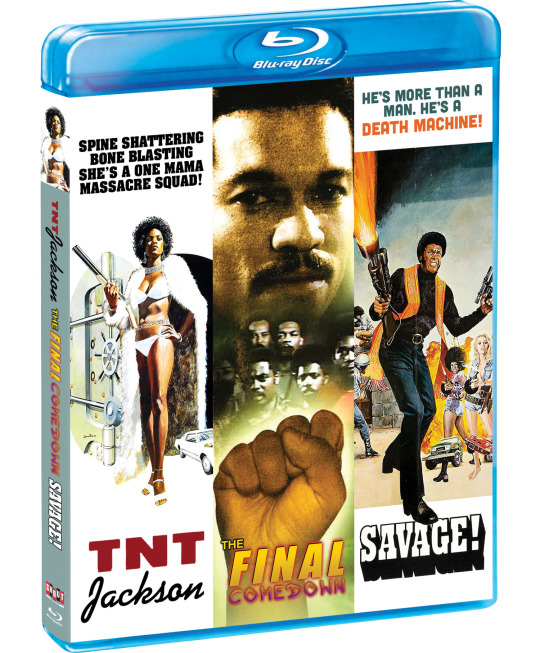
TNT Jackson, The Final Comedown, and Savage! have been released on Blu-ray together via Scream Factory. Limited to 1,500, the triple feature is available for $34.98 exclusively in the Shout Factory store.
TNT Jackson is a 1974 Blaxploitation action film directed by Cirio H. Santiago and written by actor Dick Miller (Gremlins) and Ken Metcalfe. Jeanne Bell, Stan Shaw, Pat Anderson, and Chiquito star. Roger Corman executive produces.
The Final Comedown is a 1972 Blaxploitation drama written and directed by Oscar Williams (Truck Turner), based on Jimmy Garrett's play We Own the Night. Billy Dee Williams and D'Urville Martin star. Roger Corman executive produces.
Savage is a 1973 Blaxploitation action film directed by Cirio H. Santiago and written by Ed Medard. James Iglehart, Lada Edmund Jr., and Carol Speed star. Roger Corman executive produces.
TNT Jackson has been newly scanned in 2K from the interpositive, while The Final Comedown and Savage have been newly scanned in 2K from the original camera negatives. All three films feature 2.0 Mono DTS-HD Master Audio. Special features are listed below.
TNT Jackson special features:
Theatrical trailer
Radio spot
Image gallery
Martial arts expert Diana “T.N.T.” Jackson (Jeannie Bell) is pure dynamite when she takes to the streets of Hong Kong in search of her missing brother and runs afoul of the city's most villainous drug pushers.
The Final Comedown special features:
Radio spot
Image gallery
Johnny Johnson (Billy Dee Williams) is a young man with a promising future. But push him too far, and you've got a revolution on your hands!
Savage special features:
Theatrical trailers
TV spots
Radio spot
Image gallery
James Iglehart stars as a criminal on the run who finds even more trouble when he is caught between two warring factions in a tropical nation's bloody conflict.
#tnt jackson#the final comedown#savage#roger corman#blaxploitation#shout factory#dvd#gift#70s movies#1970s movies#billy dee williams#dick miller#stan shaw#exploitation#70s action movies
14 notes
·
View notes
Text
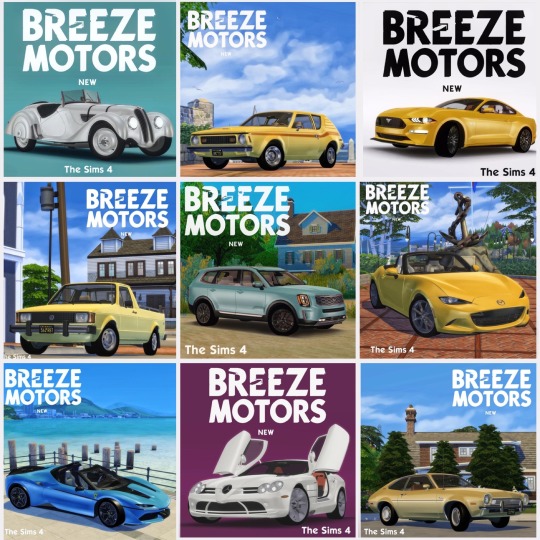
February "Starter"!
Here we go! Preview of March "Starter"!
These 9 cars available for Patrons!
Download
- 1939 BMW 328
- 1972 AMC Gremlin 🇺🇸
- 1973 Ford Pinto 🇺🇸
- 1982 Volkswagen Pickup 🇩🇪
- 2005 Mercedes-Benz SLR McLaren
- 2016 Mazda MX-5 Miata 🇯🇵
- 2017 Ferrari J50 Special Edition
- 2021 Ford Mustang GT
#sims4 #thesims4 #breezemotors #sims4cars #sims4breezemotors #thesims4cc #sims4cc #thesims4cc
13 notes
·
View notes
Text
BEWARE
WF THOUGHTS (3/14/24).
A gremlin just called me with a warning. He said: “Beware the Ides of March.”
You’re probably reading this on March 15th. Be careful. It’s supposed to be an unlucky day.
The whole “Ides of March” thing started with Julius Caesar in the year 44 BC. At the time, he was the dictator of Rome and he had many political enemies. Caesar visited a soothsayer and was warned that his life was in danger. In particular, the fortune teller told Caesar to “Beware the Ides Of March.” Caesar was assassinated by a group of Senators on March 15th. It’s a true story. We know all about the incident because of the famous play by Shakespeare.
I’m not a superstitious person. Nonetheless, I keep my eyes wide open on March 15th. I don’t take any chances. People have been worried about March 15th since the year 44 BC. If the superstition has lasted that long, there might be something to it.
I try to maintain a positive outlook on life. In that spirit, here are some positive things that happened on March 15th:
+ 1493: Columbus returned to Spain from his famous voyage.
+ 1729: The first American Nun, Sister Stanislaw Hachard, takes her vows in New Orleans.
+ 1820: Maine admitted as 23rd state.
+ 1906: The Rolls Royce Company is founded.
+ 1913: President Wilson conducted the first presidential press conference.
+ 1923: Lenin suffered his third stroke.
+ 1937: The first American blood bank is opened in Chicago.
+ 1954: Broadcaster Walter Cronkite premieres on CBS.
+ 1962: Wilt Chamberlin becomes first NBA player to score 4,000 points in a single season.
+ 1965: First “TGI Friday’s” restaurant opens in NYC.
+ 1972: The movie “The Godfather” premieres in NYC.
+ 1999: Billy Joel joins the Rock & Roll Hall of Fame.
+ 2018: Toys R Us announces that it will file for bankruptcy and close.
The items listed above are proof that good things can happen on March 15th. Don’t spend the day hiding under your bed. Listen to some good Irish music and get an early start on your Saint Patrick’s Day celebration!
0 notes
Video
tumblr
JHT5722S TRW AMORTIGUADOR American Motors Gremlin, American Motors Javelin, Ford Fairlane, Ford FalJHT5722S TRW es la marca líder a nivel mundial en diseño y producción de partes automotrices, siendo proveedor de las más prestigiosas armadoras automotrices. TRW, siempre buscamos nuevas y mejores formas de suministrar amrtiguadores que ofrezcan un viaje más tranquilo y seguro. La seguridad es nuestra maxima prioridad. American Motors Gremlin: 1974 1975 1976 1977 1978, American Motors Javelin: 1970 1971 1972 1973 1974, Ford Fairlane: 1960 1961 1962 1963 1964 1965 1966 1967 1968 1969 1970, Ford Falcon: 1960 1961 1962 1963 1964 1965 1966 1967 1968 1969 1970, Ford Granada: 1975 1976 1977 1978 1979 1980, Ford Mustang: 1971 1972 1973, Ford Ranchero: 1966 1967 1968 1969 1970 1971, Ford Torino: 1968 1969 1970 1971, Mercury Comet: 1966 1967 1968 1969, Mercury Monarch: 1975 1976 1977 1978 1979 1980, VAM American: 1973 1974 1975 1976 1977 1978, VAM Classic: 1970 1971 1972 1973 1974 1975 1976, VAM Gremlin: 1979 1980 1981 1982 1983, VAM Javelin: 1972 1973, VAM Lerma: 1980 1981 1982, VAM Rally: 1981 1982 1983 1984 American Motors Gremlin: 1974 - 1978, American Motors Javelin: 1970 - 1974, Ford Fairlane: 1960 - 1970, Ford Falcon: 1960 - 1970, Ford Granada: 1975 - 1980, Ford Mustang: 1971 - 1973, Ford Ranchero: 1966 - 1971, Ford Torino: 1968 - 1971, Mercury Comet: 1966 - 1969, Mercury Monarch: 1975 - 1980, VAM American: 1973 - 1978, VAM Classic: 1970 - 1976, VAM Gremlin: 1979 - 1983, VAM Javelin: 1972 - 1973, VAM Lerma: 1980 - 1982, VAM Rally: 1981 - 1984 American Motors Gremlin, American Motors Javelin, Ford Fairlane, Ford Falcon, Ford Granada, Ford Mustang, Ford Ranchero, Ford Torino, Mercury Comet, Mercury Monarch, VAM American, VAM Classic, VAM Gremlin, VAM Javelin, VAM Lerma, VAM Rally https://zf.tecalliance-solutions.com.mx/articles/detail/JHT5722S Mirar JHT5722S TRW AMORTIGUADOR American Motors Gremlin, American Motors Javelin, Ford Fairlane, Ford Fal
0 notes
Text
Read The RPM Magazine January 2024 Issue - Celebrating 25 Years!

As we release the January 2024 issue, we also celebrate 25 years of Smoke and Gears with all of our readers, fans, subscribers and advertisers! Thanks for your support over the years! 100% Street Car...Period!...that also runs 7's in the quarter! Alan Whitaker’s killer 1972 Chevrolet Monte Carlo is a street car through and through, and it’s also the car he dreamed of owning since he was just 11 years old. “I was at a stop light in Whiteland IN. with my father at the age of 11 when a 1970-72 Monte Carlo blue with black vinyl top and rally wheels pulled up. I told my father that was the car I wanted when I’m old enough to drive,” explained Whitaker. UNIQUE...Now here's something you just don't see every day, year...or decade! Almost 2 tons of love! The car measures 17 ½ feet long and from the factory weighed just shy, or just over 4,000 pounds, depending on options. This particular wagon was ordered as a 383 big block, 9-seater with air conditioning. BLACK WIDOW...This multi-purpose 1,800-plus horsepower blown Vette street car is an inspired build. Life can be about focusing on negatives or the positives; Eric Simpson chose the latter. Simpson was once told that he was nothing but a shade tree mechanic and would never have anything worth talking about, "I built this car to prove the naysayers wrong!" This car was literally stock everything and is now completely modified since 2019. SMALL BUT FEROCIOUS...This Grudge racer Gremlin is a small-packaged supersized serving of nitrous'd nasty! By definition, a gremlin is ‘a mischievous folkloric creature invented at the beginning of the 20th century’. American Motors' definition was 'a pal to its friends and an ogre to its enemies,' a definition that Hollywood capitalized on with their movies, depicting the tiny beast as a cute furry little friend (a Mogwai)... TECH INSIDER Welding Exhaust System - Pt. 4 - Flange/Exhaust Port Interface So we are now finally ready to weld. Well, no, not quite. In the past three articles we have discussed various welding techniques, tube fitment and backpurging. As you can see, the key to a proper header build is attention to the details. RPM HIDDEN GEM All of the Above - From the pages of July 2017 - Gary Houghtaling's 1964 Ford Falcon X275 Gary Houghtaling,s twin turbo 1964 Falcon is entirely awesome! Read the full article
0 notes
Text
Tired of boymoding. Flipping myself to 1972 AMC Gremlin.

1 note
·
View note

